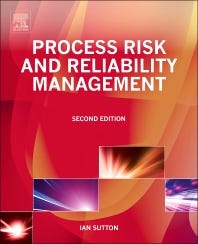Process Safety Management Definitions
We have been writing a series of posts to do with the proposed changes to the OSHA process safety management standard. (The index of the posts that have been published so far is here.)
Given that OSHA has chosen to re-open the standard, it makes sense to consider some of the basics of process safety management (PSM): what it is, what it is meant to achieve, and how it may have changed in the 30 years since OSHA first published their regulation. Therefore, we have prepared a series of four posts to do with process safety. This post is the third in the series. The posts are:
Process Safety Management Definitions (this one), and
Management a Process Safety Program.
The material in this post is taken from the book Process Risk and Reliability Management.
Process Safety Management
The definition for Process Safety Management provided by the Center for Chemical Process Safety is:
The application of management systems to the identification, understanding, and control of process hazards to prevent process-related injuries and incidents.
The following is an alternative definition.
Process Safety Management is an on-going process, involving all managers, employees and contract workers, that aims to minimize uncontrolled change from design and/or operating intent and to keep the process within its safe limits.
There is a lot to unpack in both definitions — indeed, they should be a separate post. Regarding the second definition, here are a few thoughts.
On-Going Process
In the words of the proverb, “There is always news about safety, and some of that news will be bad”.All . . .
The term “employee participation” is too restrictive. Anyone who is involved in the design, construction, operation, maintenance and support of a process facility needs to be involved.Control of Change
Virtually all incidents occur due to uncontrolled change: a process was allowed to go outside its safe limits (see below). Management of Change is at the heart of any successful process safety program.
Safe Limits
The definition in the previous section used the term “safe limits”. It is crucial that those responsible for designing and operating process facilities know the safe limits for each process variable, and that those limits are defined quantitatively. For example, the safe temperature range for a certain reaction may be 125-150ºC. If the actual temperature deviates outside of that range, then that reaction is — by definition — out of control and potentially unsafe; action must be taken to bring the temperature back into the correct range. The option of doing nothing is not an option.
The fact that the process variable has deviated outside the safe range does not mean that an emergency situation exists — management and the operators may have plenty of time to react. But they must do something because the facility must always be operated within its safe limits.
The Table below, which is taken from the book Process Risk and Reliability Management, illustrates the concept of safe limit values.
Once the safe range has been defined, management must determine how to operate their facility so that it stays within that range. In the case of the reaction temperature example, instrument set points must be adjusted, and operators trained so as to achieve the 125-150ºC range for the example just provided. All the people involved in running or maintaining the unit must know how to identify an out-of-control situation, what its consequences might be, and how they should respond. If it is management's intention to operate outside the prescribed range then the Management of Change program should be implemented in order to ensure that the new conditions are safe, that new limits have been set, or that new safeguards have been installed.
When a facility is new, the safe limits are defined by its designers. As operating experience is accumulated new safe limit values will be implemented — often through use of the hazards analysis and management of change processes.
Operating, Safe and Emergency Limits
The concept of safe limits can be extended to include operating and emergency limits, as illustrated in the sketch below, which shows values for a process variable such as pressure, temperature, level or flow rate.
An index of the posts to do with the update to the OSHA process safety standard is provided here.







